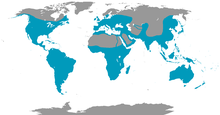Coraciiformes
| Coraciiformes Temporal range:
| |
|---|---|

| |
| European roller Coracias garrulus | |
| Scientific classification | |
| Domain: | Eukaryota |
| Kingdom: | Animalia |
| Phylum: | Chordata |
| Class: | Aves |
| Clade: | Picodynastornithes |
| Order: | Coraciiformes Forbes, 1884 |
| Families | |
|
For prehistoric taxa, see text. | |

| |
| Global distribution of the kingfisher and allies. | |
The Coraciiformes /kɒrəˈsaɪ.ɪfɔːrmiːz/ are a group of usually colourful birds including the kingfishers, the bee-eaters, the rollers, the motmots, and the todies. They generally have syndactyly, with three forward-pointing toes (and toes 3 & 4 fused at their base), though in many kingfishers one of these is missing.[citation needed] The members of this order are linked by their “slamming” behaviour, thrashing their prey onto surfaces to disarm or incapacitate them.[1]
This is largely an Old World order, with the representation in the New World limited to the dozen or so species of todies and motmots, and a mere handful of the more than a hundred species of kingfishers.
The name Coraciiformes means "raven-like". Specifically, it comes from the Latin language "corax", meaning "raven" and Latin "forma", meaning "form".[2]
Systematics
[edit]The phylogenetic relationships between the six families in the order Coraciiformes is shown below. The cladogram is based on a large study by Richard Prum and colleagues published in 2015.[3] The number of species in each family is taken from the list maintained by Frank Gill, Pamela C. Rasmussen and David Donsker on behalf of the International Ornithological Committee (IOC).[4]
| Coraciiformes |
| ||||||||||||||||||||||||||||||
Several extinct coraciiform families are only known from Paleogene fossils. They probably belong to the basal group and are sometimes difficult to assign because they were even closer still to the Piciformes (see also Neanis). In addition, there are some prehistoric genera which are likewise difficult to place into a family. At least the Eocoraciidae are very basal, but the Late Eocene (some 35 mya) Geranopteridae form a superfamily Coracioidea with the extant rollers and ground-rollers already (Mayr & Mourer-Chauviré 2000). A few prehistoric taxa of the present-day families have been described; see the family articles for details.
Taxonomic sequence
[edit]Unresolved
- Genus Quasisyndactylus (fossil; Middle Eocene of Messel, Germany) - alcediniform, basal?
- Genus Cryptornis (fossil; Late Eocene of France) – bucerotid? geranopterid?
- Family Primobucconidae (fossil), including Primobucco and Septencoracias
- Coraciiformes gen. et spp. indet. PQ 1216, QU 15640 (fossil; Late Eocene of Quercy, France: Mayr & Mourer-Chauviré 2000)
- Genus Protornis (fossil: Oligocene of Switzerland) – basal to motmotids and meropids?
A recent study suggest that the following families may belong to a separate order called Bucerotiformes. The results still in dispute though.[5]
- Family Bucorvidae (ground hornbills)
- Family Bucerotidae (hornbills)
- Family Upupidae (hoopoe)
- Family Phoeniculidae (woodhoopoes)
The Leptosomidae (cuckoo roller) probably do not belong here. The trogons are sometimes placed here as a family Trogonidae. The Late Eocene Palaeospizidae are sometimes also placed in the Coraciiformes, as are the Early to Middle Eocene Primobucconidae and the Middle Eocene to Early Oligocene Sylphornithidae. The Primobucconidae at least indeed seem to belong here.
Basal group
- Family Eocoraciidae (fossil; Middle Eocene of Messel, Germany)
- Family Geranopteridae (fossil; Late Eocene of Quercy, France – Early Miocene of Czech Republic) - includes "Nupharanassa" bohemica
- Family Coraciidae (rollers)
- Family Brachypteraciidae (ground-rollers)
- Family Meropidae (bee-eaters)
Suborder Alcedines
- Family Todidae (todies)
- Family Momotidae (motmots)
- Family Alcedinidae (kingfishers)
See also
[edit]References
[edit]- ^ "Coraciiformes". Britannica. Retrieved 13 September 2022.
- ^ Terres, John K. (1980). The Audubon Society encyclopedia of North American birds (1st ed.). New York: A. A. Knopf. p. 104. ISBN 0-394-46651-9.
- ^ Prum, R.O.; Berv, J.S.; Dornburg, A.; Field, D.J.; Townsend, J.P.; Lemmon, E.M.; Lemmon, A.R. (2015). "A comprehensive phylogeny of birds (Aves) using targeted next-generation DNA sequencing". Nature. 526 (7574): 569–573. Bibcode:2015Natur.526..569P. doi:10.1038/nature15697. PMID 26444237.
- ^ Gill, Frank; Donsker, David; Rasmussen, Pamela, eds. (December 2023). "IOC World Bird List Version 14.1". International Ornithologists' Union. Retrieved 17 June 2024.
- ^ "Bucerotiformes". tolweb.org. Retrieved 31 March 2018.
- Johansson, Ulf S. & Ericson, Per G. P. (2003): Molecular support for a sister group relationship between Pici and Galbulae (Piciformes sensu Wetmore 1960). J. Avian Biol. 34(2): 185–197. doi:10.1034/j.1600-048X.2003.03103.x PDF fulltext
- Mayr, Gerald & Mourer-Chauviré, Cécile (2000): Rollers (Aves: Coraciiformes. s.s.) from the Middle Eocene of Messel (Germany) and the Upper Eocene of the Quercy (France). J. Vertebr. Paleontol. 20(3): 533–546. DOI:10.1671/0272-4634(2000)020[0533:RACSSF]2.0.CO;2 PDF fulltext
- Terres, John K. (1980) The Audubon Society Encyclopedia of North American Birds. ISBN 0-394-46651-9
